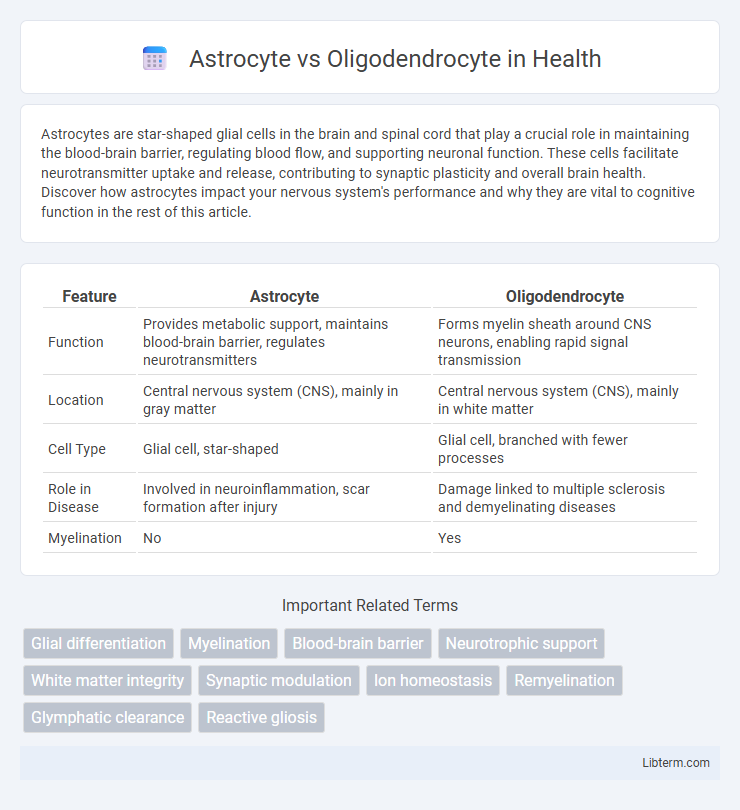Astrocytes are star-shaped glial cells in the brain and spinal cord that play a crucial role in maintaining the blood-brain barrier, regulating blood flow, and supporting neuronal function. These cells facilitate neurotransmitter uptake and release, contributing to synaptic plasticity and overall brain health. Discover how astrocytes impact your nervous system's performance and why they are vital to cognitive function in the rest of this article.
Table of Comparison
| Feature | Astrocyte | Oligodendrocyte |
|---|---|---|
| Function | Provides metabolic support, maintains blood-brain barrier, regulates neurotransmitters | Forms myelin sheath around CNS neurons, enabling rapid signal transmission |
| Location | Central nervous system (CNS), mainly in gray matter | Central nervous system (CNS), mainly in white matter |
| Cell Type | Glial cell, star-shaped | Glial cell, branched with fewer processes |
| Role in Disease | Involved in neuroinflammation, scar formation after injury | Damage linked to multiple sclerosis and demyelinating diseases |
| Myelination | No | Yes |
Introduction to Glial Cells
Astrocytes and oligodendrocytes are two primary types of glial cells in the central nervous system, crucial for maintaining neuronal health and function. Astrocytes regulate the blood-brain barrier, provide metabolic support, and modulate neurotransmission, while oligodendrocytes are responsible for forming myelin sheaths that insulate axons and enhance signal propagation. Both cell types contribute to neural repair and homeostasis, but their specialized roles highlight distinct aspects of glial cell functionality in brain physiology.
Overview of Astrocytes
Astrocytes are star-shaped glial cells in the central nervous system that provide structural support, maintain the blood-brain barrier, and regulate neurotransmitter levels. These cells play a critical role in ion homeostasis, particularly potassium buffering, and influence synaptic transmission and plasticity. Unlike oligodendrocytes, which primarily produce myelin for axonal insulation, astrocytes contribute to neural repair and metabolic support for neurons.
Overview of Oligodendrocytes
Oligodendrocytes are specialized glial cells in the central nervous system responsible for forming myelin sheaths around axons, facilitating rapid electrical impulse conduction. Unlike astrocytes, which provide metabolic support and maintain the blood-brain barrier, oligodendrocytes directly enhance neuronal signal transmission through insulation. These cells play a critical role in neural network efficiency and are implicated in demyelinating diseases such as multiple sclerosis.
Origins and Developmental Pathways
Astrocytes arise from radial glial cells in the ventricular zone during embryonic development, playing a key role in synapse formation and blood-brain barrier maintenance. Oligodendrocytes originate from oligodendrocyte precursor cells (OPCs) derived from the subventricular zone, undergoing distinct stages of proliferation, migration, and differentiation to enable myelination of CNS axons. Both glial cell types follow tightly regulated developmental pathways influenced by signaling molecules such as Sonic hedgehog (Shh) and platelet-derived growth factor (PDGF).
Structural Differences
Astrocytes have a star-shaped structure with numerous long, branching processes that provide support and nutrient transport within the central nervous system. Oligodendrocytes feature fewer, shorter processes and are responsible for forming the myelin sheath around multiple axons, enhancing neural signal conduction. The structural complexity of astrocytes relates to their role in maintaining the blood-brain barrier and extracellular environment, while oligodendrocytes' compact form optimizes their myelination function.
Key Functions of Astrocytes
Astrocytes primarily maintain the blood-brain barrier, regulate neurotransmitter levels, and support neuronal metabolism, ensuring optimal synaptic function and ion balance in the central nervous system. Unlike oligodendrocytes, which myelinate axons to enhance signal conduction speed, astrocytes modulate synaptic activity and contribute to neurovascular coupling. Their ability to influence brain homeostasis and repair highlights their critical role in neural health and disease.
Key Functions of Oligodendrocytes
Oligodendrocytes are specialized glial cells responsible for the formation of myelin sheaths around axons in the central nervous system, facilitating rapid electrical signal transmission. Unlike astrocytes, which support metabolic and structural functions in the brain, oligodendrocytes specifically enhance neuronal communication efficiency and maintain axonal integrity. Their myelination process is crucial for proper nerve conduction velocity and neuroprotection.
Role in Neurological Disorders
Astrocytes contribute to neurological disorders by regulating neurotransmitter levels, maintaining blood-brain barrier integrity, and modulating inflammatory responses, which can impact conditions like Alzheimer's disease and multiple sclerosis. Oligodendrocytes are crucial for myelination of neurons, and their dysfunction is directly linked to demyelinating diseases such as multiple sclerosis and leukodystrophies. Both cell types influence neurodegeneration and repair mechanisms, making them key targets for therapeutic interventions in various neurological disorders.
Interactions with Neurons
Astrocytes support neuronal function by regulating neurotransmitter levels and maintaining the blood-brain barrier, facilitating synaptic transmission and ion homeostasis. Oligodendrocytes enhance neuronal signaling by producing myelin sheaths that insulate axons, increasing the speed and efficiency of electrical impulses. Both glial cells interact closely with neurons to optimize neural communication and maintain central nervous system health.
Future Research and Clinical Implications
Astrocytes play a crucial role in maintaining the blood-brain barrier and modulating synaptic activity, making them key targets for future neurodegenerative disease therapies. Oligodendrocytes are essential for myelination in the central nervous system, and advancing research on their regenerative capacity could revolutionize treatments for demyelinating conditions like multiple sclerosis. Understanding the interplay between astrocyte-mediated neuroinflammation and oligodendrocyte-driven remyelination may lead to innovative clinical strategies for neurorepair and cognitive restoration.
Astrocyte Infographic

 libterm.com
libterm.com